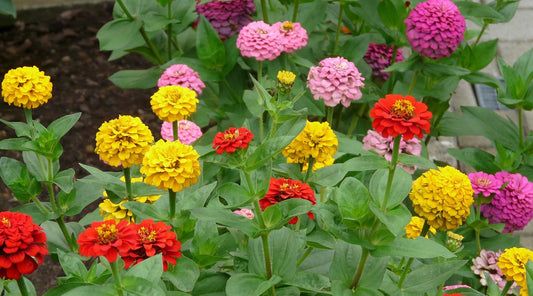Battling Bugs with Heart: How to Identify and Control Common Garden Pests in Early Summer
Ah, early summer the sun's a little warmer, the garden is bursting with life, and if you’re like me, you’re finally starting to see the fruits (and veggies) of all that spring prep work. But just when you're settling into a peaceful watering session or admiring your first tomato blossoms… you notice it. Chewed leaves. Sticky residue. Maybe even a little green aphid party on your roses. Yep, pest season has arrived.
Don’t worry, you’re not alone. And you don’t need to reach for harsh chemicals or panic. Let’s walk through the most common early summer garden pests and how to deal with them gently, effectively, and with the same care we bring to every part of gardening.
Welcome to Bug Season: Why Early Summer Brings the Pests Out
As soon as the nights stop dipping into the 40s and daytime temps stay consistently warm, pests come out to play. The fresh growth from our plants is like a dinner invitation for all sorts of creepy-crawlies, from munching beetles to sap-sucking mites.
But while they might be annoying, most pests are manageable with some observation, prevention, and a few trusty tricks up your sleeve. Early action means you’ll avoid major infestations later and keep your harvest on track.
Know Your Garden Foes: Common Early Summer Pests
Here are a few of the most common villains you’re likely to encounter and how to recognize them.
Aphids
Tiny and green (though they can also be black, red, or white), aphids gather in clusters on new growth. They suck sap from leaves and stems, leaving plants curled and stunted. You’ll also see a sticky residue called honeydew that can lead to sooty mold.
Tomato Hornworms
These chunky green caterpillars can strip a tomato plant practically overnight. They’re camouflaged well, but you’ll notice chewed leaves and droppings first. My cats used to bring them in the house and I'm telling you, stepping on one without shoes is no fun. Yuck.
Japanese Beetles
These shiny metallic beetles love to skeletonize leaves. They often show up in groups and favor roses, beans, and fruit trees. They love figs.
Slugs and Snails
You’ll spot the slimy trails and jagged holes in leaves, especially in moist, shaded areas. These guys love tender greens and low-growing plants.
Spider Mites
Tiny and hard to see, spider mites cause leaves to turn speckled yellow and dry out. A sure sign is the fine webbing they leave behind, especially on the undersides of leaves.
Be a Garden Detective: How to Spot the Early Signs
Catching pests early is half the battle. Make it a habit to walk your garden in the morning or evening with a keen eye. Look under leaves, inspect tender new growth, and check for:
- Curling or yellowing leaves
- Holes, chewed edges, or missing foliage
- Sticky residue (a telltale sign of aphids or whiteflies)
- Black spots or mold
- Webbing or clusters of tiny insects
I make it part of my quiet time with the garden with my coffee in one hand, Terra Planter in the other. It’s peaceful, and it keeps me tuned in to what my plants need.
Friendly Fixes First: Natural and Organic Pest Control Options
Before you go nuclear, start with nature.
Beneficial Insects
Ladybugs, lacewings, and praying mantises are garden heroes. You can buy them online or encourage them by planting yarrow, dill, or fennel.
Companion Planting
Some plants naturally repel pests. Try marigolds near tomatoes to deter nematodes and aphids, or basil near peppers to keep away mosquitoes and flies.
Homemade Remedies
- Garlic Spray: Blend garlic cloves with water and a dash of dish soap.
- Neem Oil: A natural, biodegradable oil that repels many pests when sprayed on leaves.
- Diatomaceous Earth: A fine powder that’s deadly to insects with exoskeletons but safe for humans and pets.
Remember, healthy soil and well-watered, stress-free plants are naturally more pest-resistant, so good garden care is your first line of defense.
When to Take Action: Manual and Physical Controls
Sometimes, you’ve got to get a little hands-on.
- Hand-picking: Yes, it sounds old-fashioned, but picking off hornworms, beetles, and slugs works. I like to keep a small bucket of soapy water nearby to drop them into. Sometimes I just throw them out in the yard so the birds can get them.
- Traps and Barriers: Beer traps for slugs, sticky traps for flying pests, and row covers to keep bugs off tender plants.
- Mulch Wisely: Use straw or shredded leaves to deter soil-dwelling bugs but keep it dry to avoid slugs.
Clean up fallen fruit, prune off infested leaves, and weed regularly to reduce hiding spots and breeding grounds. When it comes to the aforementioned Japanese beetles, keeping the figs picked as soon as they are ripe reduces the swarms. They seem to show up after the fruit is ripe.
Garden Tools to the Rescue: Must-Haves for Pest Patrol
A few trusty tools make pest patrol easier—and more enjoyable:
- Garden Twist Tiller – This tool is perfect for turning over soil to expose hidden larvae and improve drainage, which discourages many pests.
- Terra Weeder – Use it to dig around plants and pull up weeds (a common hiding place for bugs) with surgical precision.
- Garden Kneeler Pad – You’ll spend a lot of time inspecting under leaves so you might as well be comfortable while you’re down there.
Using the right tools helps you work smarter, not harder and adds a little joy to the process.
A Gardener’s Mindset: Patience, Persistence, and Perspective
Look, I’ve lost battles to bugs before. Whole broccoli crops, years ago. I’ve done the late-night flashlight patrol for hornworms and even talked (maybe pleaded) with a few tomato plants. But what I’ve learned is this: pests are part of the garden ecosystem. The goal isn’t perfection, it’s balance.
When you stay present, observant, and consistent, your garden will thrive despite the occasional bug nibble. And you’ll grow as a gardener in the process.
Wrap-Up: Your Garden Is Stronger Than You Think
Early summer pests may be inevitable, but they don’t have to take over. With a little vigilance, a lot of heart, and the right tools and tactics, you can keep your garden healthy, thriving, and full of life yours included.
Got a pest tip, story, or favorite remedy? I’d love to hear it in the comments. And if you’re looking for more tools to help you garden smarter this summer, check out the full line of tools in the Yard Butler shop.
Let’s keep growing, bugs and all.







